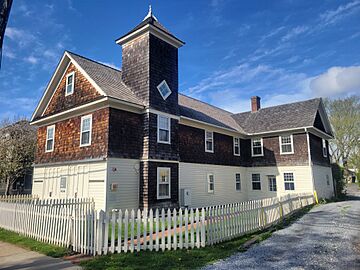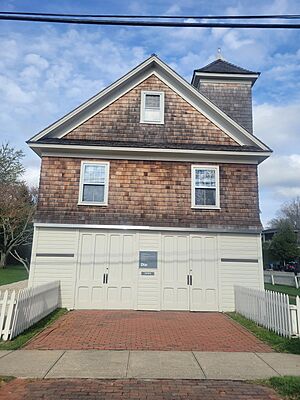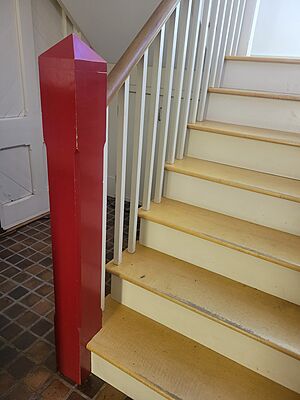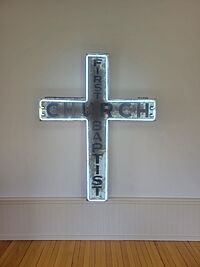Dia Bridgehampton facts for kids

Exterior of Dia Bridgehampton
|
|
| Former name | Dan Flavin Art Institute |
|---|---|
| Established | 1983 |
| Location | 23 Corwith Avenue Bridgehampton, New York, US |
| Type | Art museum |
| Key holdings | nine works on permanent display by Dan Flavin |
| Collections | Modern and contemporary art |
| Founder | Dan Flavin and Dia Art Foundation |
| Owner | Dia Art Foundation |
| Public transit access | Bridgehampton station, Montauk Branch of the Long Island Rail Road |
Dia Bridgehampton, previously known as the Dan Flavin Art Institute, is a museum in Bridgehampton, New York run by the Dia Art Foundation. Originally built in 1909 as a firehouse, the building was sold to the First Baptist Church of Bridgehampton in 1924. The church renovated and expanded the building in 1947 and used it as a place of worship through the mid-1970s. The congregation grew and, in 1979, they sold the building to the Dia Art Foundation. Dia renovated the building into a single-artist museum for Dan Flavin as well as a rotating exhibition space. The building re-opened in 1983 as the Dan Flavin Art Institute.
The second floor and vestibule of the museum house ten works by Dan Flavin on permanent display and the first floor houses a gallery for temporary exhibitions. In addition, the rear of the second floor holds a display of historic memorabilia from the First Baptist Church including the church doors, a frosted glass window, a large neon cross, and the 1947 church cornerstone.
In early 2020, Dia stopped calling the building the "Dan Flavin Art Institute" and began calling it "Dia Bridgehampton". The Flavin works within the building are now considered the "Dan Flavin Art Institute" while the rotating gallery makes up the rest of "Dia Bridgehampton". This museum is one of the twelve locations and sites the Dia Art Foundation manages.
Contents
History
Bridgehampton Hook and Ladder Company
Bridgehampton, New York, organized a volunteer firefighting service in 1895. The newly formed Bridgehampton Hook and Ladder Company had its first meeting on May 15, 1895, with 15 members attending. Early meetings were held in Atlantic Hall on Ocean Avenue. The company purchased its first engine in 1899 and stored it in the barn belonging to the company foreman, Ed Roger. The engine was subsequently moved to the Academy on Ocean Road and, in 1900, to a building on the property of J. A. Sanford, one of the company's trustees. In 1905 a building lot on Corwith Avenue, then known as Kansas Avenue, was purchased for $270 (equivalent to $8,794 in 2022) with the intent of building a headquarters for the company. The building was completed and dedicated in 1909 at a total cost of $1593 (equivalent to $51,885 in 2022). The two story, plus attic, building held fire fighting equipment on the first floor and a meeting room, or "Fireman's Hall" on the second. An old bell was purchased from the academy for $5 and installed in the building's bell tower.
In 1921 Bridgehampton considered building a new Community House which would include a new firehouse. A motion was approved that stated if quarters were made for the fire department they would move in to the new building and sell the firehouse on Corwith Avenue with the proceeds going towards the construction of the Community House. The Community House was completed in 1923 and the Fire Company moved to the new quarters there. The Bridgehampton Hook and Ladder Company was dissolved and on May 28, 1923, and a new fire district was approved by the Town Board of Supervisors. The new firefighting organization was named the Bridgehampton Fire Department.
First Baptist Church of Bridgehampton
In 1924 the First Baptist Church of Bridgehampton, under the leadership of H.D. Strotter, purchased the turreted, shingle-style building and began using it as a church. In February 1947 a vote was taken by the congregation about possibly building a new church. The vote passed but the reverend decided to renovate this building instead. This 1947 renovation to the building including a new cornerstone laid by the Prince Hall Freemasonry, also known as the African American Freemasonry. In this renovation the main entrance was moved from the front of the building to the side and the façade was extended. An annex was also constructed for a first-floor garage with an apartment over it. The building remained in use as a place of worship through the mid-1970s. At this point the First Baptist Church congregation grew too large and a new church was erected nearby.
Dia and Dan Flavin
In 1974, the Dia Art Foundation was established by Heiner Friedrich, Schlumberger heiress Philippa de Menil, and Helen Winkler to help artists realize ambitious projects whose scale and scope is not feasible within the normal museum and gallery systems. In 1979 the Dia Art Foundation purchased the former firehouse and church building explicitly to house a long term exhibition of Dan Flavin's work as well as a rotating exhibition space. Flavin was a resident of Wainscot at the time, but had previously lived in Bridgehampton for several years. Flavin was drawn to this building due to its accessible location and open floor space.
Once purchased, there were some initial repairs made to the roof of the building but few additional repairs were made over the next several years. Renovations began in earnest in September 1982 with the architect Richard Gluckman designing the building, under the direction of Flavin. Gluckman had connections to both Flavin and Dia, having previously worked with Flavin on a 1977 installation for the Dia founders. Gluckman's first commission to create a full-scale art gallery was for the Dia Center for the Arts on West 22nd Street, now Dia Chelsea.
The renovation of the former firehouse and church included repairs to the exterior, new landscaping, and extensive remodeling of the interior. Interior work included the addition of a fire sprinkler system and a large scale rewiring of the building to accommodate the power draws associated with Flavin's fluorescent light sculptures. Ultraviolet-filtered glass windows were installed with grey mylar shades to help control the lighting inside. The newel post was painted fire-engine-red, a reference to the building's use as a fire station, and a small gallery on the second floor was created to hold memorabilia from the renovation process including the church doors and a neon cross. On the exterior gutters and electrical cables were removed while doors, paneling, and shingles were restored. A blue light was installed under the lower cornice. When talking about the design of the first floor exterior of the building Flavin stated, "We've tried to put the firehouse façade back on it," referencing a newly made set of double doors which duplicate the look of the original firehouse doors that allowed the engines in and out.
The building reopened on June 18, 1983, as the Dan Flavin Art Institute and was named after James Schaeufele, the site supervisor of the renovation project. In its original configuration, the museum was created to house a permanent display of Flavin's work in the building's vestibule and second floor, an artist's archive, a printmaking workshop area, and a rotating exhibition space. An adjacent residential property was repurposed to hold the administrative center of the institution.
An exhibit of fire department memorabilia, much like the display of church objects already installed, was planned to be assembled and installed in the bell tower after the opening of the museum. An apartment on the second floor was also planned for visiting printmakers and an intaglio press was planned to be installed in the former kitchen space. Without any physical changes to the structure occurring, Dia switched from calling this building the "Dan Flavin Art Institute" to calling it "Dia Bridgehampton" between a November 21, 2019 and a January 29, 2020 press release. Now, the "Dan Flavin Art Institute" is considered to only be the Flavin works inside Dia Bridgehampton, while the rotating gallery makes up the rest of "Dia Bridgehampton". One exhibit per year is displayed in this rotating gallery with a focus on presenting work by artists living or working on Long Island.
Dan Flavin Art Institute
The Dan Flavin Art Institute is a permanent display of Dan Flavin's work within Dia Bridgehampton. This display consists of nine works in fluorescent light and one drawing. The institute opened with the building in 1983 and is a mini-retrospective touching on each of the major type of work he created with this medium. Dia expresses that the lights and the architecture should be viewed as a "single, continuous installation," and that "Flavin provided an experience built of provocative contrasts—between colors, intensities of light, structure and formlessness, the obvious and the curious, the serious and the humorous."
The following table lists the works on permanent display.
| Title | Date | Material | Edition | Owner |
|---|---|---|---|---|
| red out of a corner (to Annina) | 1963 | Fluorescent light and metal fixtures | 2/3 | The Estate of Dan Flavin |
| untitled | 1976 | Fluorescent light and metal fixtures | 2/3 | Dia Art Foundation |
| untitled (to Robert, Joe, and Michael) | 1975-81 | Fluorescent light and metal fixtures | 2/3 | Dia Art Foundation |
| untitled (to Jan and Ron Greenberg) | 1972-73 | Fluorescent light and metal fixtures | 2/3 | Dia Art Foundation |
| untitled (in honor of Harold Joachim) 3 | 1977 | Fluorescent light and metal fixtures | 1/3 | Dia Art Foundation |
| untitled (to Katharina and Christoph), (from the European Couples series) |
1966-71 | Fluorescent light and metal fixtures | 1/5 | Dia Art Foundation |
| untitled (to Jim Schaeufele) 1 | 1972 | Fluorescent light and metal fixtures | 1/3 | Dia Art Foundation |
| untitled (to Jim Schaeufele) 2 | 1972 | Fluorescent light and metal fixtures | 1/3 | Dia Art Foundation |
| untitled (to Jim Schaeufele) 3 | 1972 | Fluorescent light and metal fixtures | 1/3 | Dia Art Foundation |
| untitled drawing for icon IV (the pure land) (to David John Flavin [1933–1962]) |
1962 | Pencil and chalk on paper | N/A | Collection of Stephen Flavin |
Temporary exhibitions
The first floor of Dia Bridgehampton houses a gallery where temporary exhibitions are presented. This gallery was originally envisioned by Flavin as a venue for changing exhibitions as well as a print shop. When the museum opened the plans for this gallery were to present prints created on the premises, historical exhibits of late 19th to early 20th century etchings, drawings, and watercolors, as well as contemporary work by artists such as James Turrell and Donald Judd. When the Dan Flavin Art Institute opened in 1983 the first exhibit in this gallery was a presentation of Flavin's the diagonal of May 25th, 1963 (to Constantin Brancusi), his first work using fluorescent light fixtures, and preparatory drawings. The gallery has gone through many different curatorial shifts since this first exhibit.
Exhibitions under Flavin
The first set of exhibitions were organized directly by Flavin, with the first being a selection of paintings by Michael Venezia presented in 1983. These early exhibitions focused on contemporary artists of the time, historic artists and crafts persons, as well as Flavin's own work. Exhibitions of this time period included drawings by James Brooks and an exhibition of locally made arts and crafts style art, furniture, and pottery in 1984, and the presentation of Flavin's Untitled 2 in 1985. This series of exhibits culminated in 1987 with a memorial tribute exhibition to Andy Warhol, exhibited five months after his death, featuring paintings by Warhol, photography by Stephen Shore, and Native American blankets from Warhol's collection.
In 1987 Dia reassessed the direction the first floor gallery should take and turned to Henry Geldzahler, the former curator of 20th-century art at the Metropolitan Museum of Art, to curate a new series. He broke each season into three exhibits, two solo shows, and one larger group show of works by artists living in the East End of Long Island. This new format began in 1988 and brought exhibitions by artist such as Cy Twombly that year, Louise Bourgeois in 1989, Enrique Castro-Cid in 1990, Alice Neel in 1991, John Chamberlain and another exhibition of Andy Warhol work, this time focusing on his oxidation paintings, in 1992, and Manuel Neri in 1993.
Exhibitions after Flavin's death
In 1995 a new series was initiated with the exhibit Dan Flavin's Collection of Japanese Drawings and Prints, a display of objects drawn directly from Flavin's art collection and organized by him. This series was supposed to be organized by Flavin, but he died the next year leaving the series unrealized. For several years after his death the gallery was used to display his work including his drawings in 1997 and 1998, and a selection of his early wall sculptures from 1999 to 2003.
Dia returned the gallery to presenting artists other than Flavin with a three-year long exhibit of prints by Fred Sandback from 2004 to 2006, an exhibit of foam and paper sculptures by John Chamberlin's in 2007, and two exhibits of large scale collage by Imi Knoebel in 2008 and 2009–2010. 2010 also saw a short exhibition of Flavin's drawings of the Hudson valley in relationship to drawing made by the Hudson River School in the late 19th century.
For the next several years the gallery was largely used to present exhibitions that related to, or were extensions of, larger exhibits at Dia Beacon or elsewhere. These exhibitions included a series of works on paper as part of Koo Jeong A's Constellation Congress from 2010 to 2011, new work by Jean-Luc Moulène which accompanied Opus + One at Dia Beacon in 2011–12, and A Friendship: Carl Andre’s Works on Paper from the LeWitt Collection presented in conjunction with a retrospective of his work at Dia Beacon. Another exhibition of works by John Chamberlin was also presented in 2013–14. This was, once again, followed by a several-year long exhibit of Flavin's early wall sculptures from 2015 to 2017.
Focus on Long Island artists
Since 2017, The exhibitions in the first-floor gallery are primarily displays of work by a single artist who resides or works on Long Island. For these exhibitions Dia invites artists to consider the space they are exhibiting in. Artists have used this prompt to make work that responds to the Flavin sculptures in the gallery upstairs, the history of the building, the land and the surrounding region, or interactions with the sensibilities and physical qualities of the space. Artists presenting in this series include Mary Heilmann (2017-2018), Keith Sonnier (2018-2019), Jacqueline Humphries (2019-2020), and Jill Magid (2020-2021).
Recently the exhibitions, while based largely in the first floor gallery, have included elements beyond the walls of the building. Maren Hassinger included a new galvanized steel rope sculpture installed in Dia Bridgehampton's back lawn for her 2021-2022 exhibit, Leslie Hewitt installed a bronze silhouette on a boulder also on the backyard in 2022–2023, and Tony Cokes purchased advertisements on nearby electronic billboards owned by the Shinnecock Indian Nation in 2023–2024.
Historic display
The back room on the second floor contains a display of historic memorabilia from the First Baptist Church. This display includes the church doors and a frosted glass window. This room also includes a large neon cross from the church as well as the 1947 church cornerstone which was removed and preserved here. This cornerstone was laid by Tyre Lodge No. 91. F. & A. M., a chapter of Prince Hall Freemasonry, also known as the African American Freemasonry. This chapter is still active today and named after Prince Hall, an American abolitionist, leader in the free black community in Boston, and active in the back-to-Africa movement.
Dia notes in a pamphlet that this space, and its neon cross, "alludes to Flavin’s transformation of light and fluorescent fixtures from spiritual associations or mundane service to contemporary “icons” depleted of religious or utilitarian significance."






